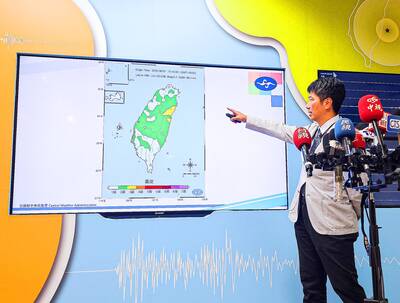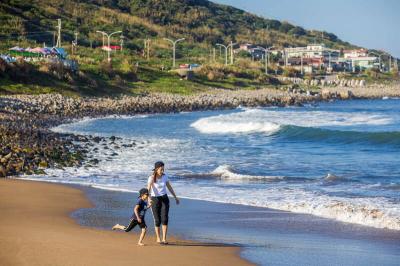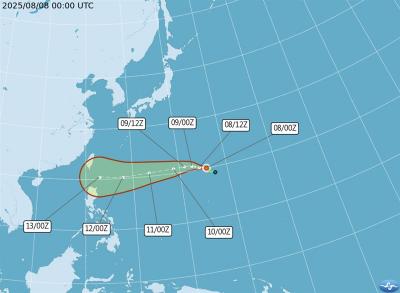A research team at Taipei Veterans General Hospital (TVGH) has discovered that specific concentrations of micro ribonucleic acid (microRNA) in the blood can help determine migraine risk and disease status, with an accuracy rate of more than 90 percent.
It is one of the few studies worldwide to successfully identify biomarkers during a migraine attack, the team told a news conference in Taipei on Monday.
Migraine is one of the most common neurological disorders globally, with a prevalence of up to 15 percent, said TVGH deputy superintendent Wang Shuu-jiun (王署君), who is also the dean of the College of Medicine at National Yang Ming Chiao Tung University.

Photo: Lin Hui-chin, Taipei Times
More than 1 billion people worldwide suffer from migraines, including nearly 2 million in Taiwan, he said.
Migraine is the second-leading cause of disability among people aged 15 to 49, severely impacting work, education and quality of life, and women are three times more likely than men to be affected, he said.
Chen Shih-pin (陳世彬), director of TVGH’s Division of Translational Research, said that migraines are complex and involve distinct “attack” and “non-attack” phases, during which the body undergoes various changes, making the condition difficult to study.
At present, there are no quantifiable biomarkers or objective diagnostic tools for migraines, he said, adding that even MRI scans often show no abnormalities, so doctors must rely on patients’ subjective descriptions, which leads to migraines often being dismissed as a “non-serious illness.”
Migraines are often attributed to “constitution,” a concept referring to the interaction of genes and environmental factors, some of which are detectable, Chen said.
For example, research by last year’s Nobel laureates in physiology or medicine highlighted how microRNAs — molecules composed of about 20 to 25 nucleotides — regulate the process of gene expression and influence DNA function, he said.
The team recruited 120 participants, who were divided into four groups: people in migraine attack phases, in non-attack phases, with chronic migraines and a healthy control group, Chen said.
Using next-generation sequencing, the researchers identified blood-based microRNAs, potentially related to migraines, he said.
The findings were validated in 197 people, and the team developed a composite predictive model based on microRNA concentration differences to identify migraine status and risk, Chen said.
That model achieved an accuracy rate of more than 90 percent in large-scale validation groups, demonstrating that even complex and variable neurological conditions can be accurately predicted by integrating multiomics data with clinical information, said team member Chen Hsuan-yu (陳璿宇), a research fellow at Academia Sinica’s Institute of Statistical Science and Smart Medicine Special Center, said.
The research also showed how migraine-related microRNAs are involved in regulating the pathways of the hormones estrogen and prolactin, said Chang Ya-hsuan (張雅媗), an assistant research fellow at the National Health Research Institutes’ Institute of Molecular and Genomic Medicine.
This not only helps explain why women are more susceptible than men to migraines, but also provides important evidence for research into sex differences in neurological disorders, she said.
Chen Shih-pin said the study is one of the few worldwide that provides real-time identification of migraine attacks, with biological evidence.
He said he hoped that in the future, a simple drop of blood could be used for quick and easy clinical tests, allowing doctors to identify high-risk patients before migraine attacks, and monitor disease progression.
This would allow for timely treatment to alleviate pain as well as assessment of the therapeutic response, thereby advancing the goal of precision medicine, he said.
The results of the study were published in last month’s issue of Brain a prestigious journal in the field of neuroscience.
Additional reporting by Jason Pan

Aftershocks from a magnitude 6.2 earthquake that struck off Yilan County at 3:45pm yesterday could reach a magnitude of 5 to 5.5, the Central Weather Administration (CWA) said. Seismological Center technical officer Chiu Chun-ta (邱俊達) told a news conference that the epicenter of the temblor was more than 100km from Taiwan. Although predicted to measure between magnitude 5 and 5.5, the aftershocks would reach an intensity of 1 on Taiwan’s 7-tier scale, which gauges the actual effect of an earthquake, he said. The earthquake lasted longer in Taipei because the city is in a basin, he said. The quake’s epicenter was about 128.9km east-southeast

GENSLER SURVEY: ‘Economic infrastructure is not enough. A city needs to inspire pride, offer moments of joy and foster a sense of belonging,’ the company said Taipei was named the city with the “highest staying power” in the world by US-based design and architecture firm Gensler. The Taiwanese capital earned the top spot among 65 cities across six continents with 64 percent of Taipei respondents in a survey of 33,000 people saying they wanted to stay in the city. Rounding out the top five were Vietnam’s Ho Chi Minh City (61 percent), Singapore (59 percent), Sydney (58 percent) and Berlin (51 percent). Sixth to 10th place went to Monterrey, Mexico; Munich, Germany; Sao Paulo, Brazil; Vancouver; and Seoul. Cities in the US were ranked separately, with Minneapolis first at

The New Taipei City Government today warned about the often-overlooked dangers of playing in water, and recommended safe swimming destinations to cool off from the summer heat. The following locations in the city as safe and fun for those looking to enjoy the water: Chienshuiwan (淺水灣), Baishawan (白沙灣), Jhongjiao Bay (中角灣), Fulong Beach Resort (福隆海水浴場) and Sansia District’s (三峽) Dabao River (大豹溪), New Taipei City Tourism and Travel Department Director-General Yang Tsung-min (楊宗珉) said. Outdoor bodies of water have variables outside of human control, such as changing currents, differing elevations and environmental hazards, all of which can lead to accidents, Yang said. Sudden

Tropical Storm Podul has formed over waters north-northeast of Guam and is expected to approach the seas southeast of Taiwan next week, the Central Weather Administration (CWA) said today. The 11th Pacific storm of the year developed at 2am over waters about 2,660km east of Oluanpi (歐鑾鼻), Pingtung County — Taiwan's southernmost tip. It is projected to move westward and could have its most significant impact on Taiwan on Wednesday and Thursday next week, the CWA said. The agency did not rule out the possibility of issuing a sea warning at that time. According to the CWA's latest update, Podul is drifting west-northwest